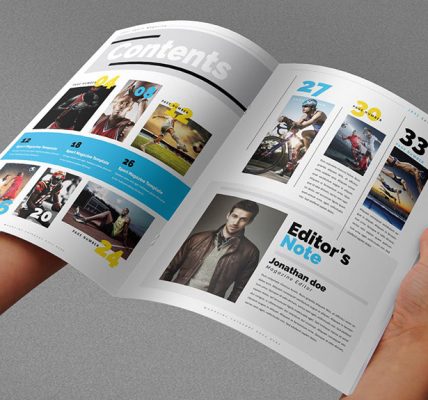introduction
Magazines are diverse in content, style, and format, catering to a broad spectrum of interests and readers. While their content captivates, the physical dimensions of magazines play a crucial role in their design, functionality, and appeal. From the compact convenience of pocket-sized editions to the expansive canvases of oversized publications, the size of a magazine is a fundamental aspect that influences its production, distribution, and reader engagement. This article delves into the various dimensions of magazines, exploring standard sizes, industry-specific formats, and the factors that determine these dimensions.

Standard Magazine Sizes
The dimensions of magazines are often dictated by industry standards and norms, which have evolved over time to optimize for print production, handling, and readership experience. Here are some common sizes:
1. Digest Size
- Dimensions: Approximately 5.5 x 8.25 inches (140 x 210 mm)
- Examples: Reader’s Digest, certain literary journals
- Characteristics: Digest-size magazines are smaller and more portable. They are often used for publications with concise, easy-to-read content. This size is also popular for catalogs and niche markets.
2. Standard Size
- Dimensions: Around 8.5 x 11 inches (216 x 279 mm)
- Examples: National Geographic, Time Magazine
- Characteristics: The standard size is the most prevalent in the magazine industry. It balances readability with the ease of handling and storage. This size is ideal for a variety of content types, including in-depth articles, rich photography, and advertisements.
3. Oversized Magazines
- Dimensions: Typically 9 x 12 inches (229 x 305 mm) or larger
- Examples: W Magazine, certain fashion or art publications
- Characteristics: Oversized magazines offer more space for visuals and design elements, making them popular for fashion, art, and luxury publications. The larger format provides a more immersive experience but can be less convenient for transport and storage.
Custom Sizes
Beyond the standard sizes, many magazines adopt custom dimensions to stand out on newsstands and better serve their specific content and audience needs. Custom-sized magazines are often found in niche markets or special editions. Here are a few examples:
- Square Magazines: Dimensions like 8.5 x 8.5 inches (216 x 216 mm) are used for a unique, modern look, often favored by design-oriented publications.
- Mini Magazines: Sizes smaller than the digest format, such as 4 x 6 inches (102 x 152 mm), are used for pocket-sized guides, promotional materials, or children’s magazines.
- Large Format Magazines: Some publications, especially those focusing on visual arts or photography, use dimensions larger than the oversized standard, such as 11 x 17 inches (279 x 432 mm), to showcase their content.
Factors Influencing Magazine Dimensions
Several factors influence the choice of a magazine’s dimensions, ranging from practical considerations to artistic intent. Here are some of the key factors:
1. Target Audience
The intended readership plays a significant role in determining the size of a magazine. For example, fashion magazines targeting a younger demographic may opt for oversized formats to highlight visual content, while business-oriented magazines might choose a more compact, standard size for easy handling and professional presentation.
2. Content Type
The nature of the magazine’s content also dictates its dimensions. Magazines rich in visual content, such as photography, art, or design magazines, benefit from larger formats that allow for high-quality image reproduction and impactful layouts. Conversely, text-heavy publications, like literary journals or academic magazines, may favor smaller, more portable sizes.
3. Production Costs
Printing and production costs are directly affected by the magazine’s size. Larger magazines require more paper and ink and might incur higher shipping costs due to their bulk. Publishers must balance these costs against the potential benefits of a more striking, larger format.
4. Distribution and Retail Display
How a magazine is distributed and displayed also impacts its size. Standard sizes are easier to distribute and fit neatly on newsstands and in retail racks. Custom sizes, while potentially more eye-catching, may require special display arrangements or packaging.
5. Branding and Differentiation
Magazine dimensions can be a key element of branding. Unique sizes can help a publication stand out from competitors and reinforce its identity. For instance, a square magazine may convey modernity and innovation, while an oversized format might suggest luxury and exclusivity.

Magazine Dimensions in Different Industries
Different industries have unique requirements and conventions for magazine sizes. Here’s a look at how dimensions vary across some popular genres:
1. Fashion Magazines
Fashion magazines often opt for oversized formats to highlight high-quality photographs and vibrant visual content. Titles like Vogue and Harper’s Bazaar use dimensions around 9 x 12 inches or larger to provide ample space for showcasing designer spreads and detailed imagery.
2. News and Current Affairs
News magazines typically adhere to standard sizes, such as 8.5 x 11 inches, to maintain a balance between visual appeal and practicality. Magazines like Time and The Economist use this format to present a mix of articles, photographs, and infographics in a reader-friendly layout.
3. Trade and Professional Journals
Professional journals and trade magazines often favor standard or slightly smaller dimensions, around 8 x 10 inches, to ensure they are easy to read and store. These publications prioritize content density and accessibility, catering to industry professionals seeking informative and detailed articles.
4. Art and Photography Magazines
Art and photography magazines frequently use larger or custom sizes to provide a canvas for showcasing high-resolution images and creative layouts. Publications like Aperture or Juxtapoz might use dimensions like 10 x 13 inches or larger to give their visual content maximum impact.
5. Children’s Magazines
Magazines aimed at children often use smaller, more manageable sizes, such as 7 x 10 inches. This size is easier for young readers to handle and is suitable for colorful, engaging content designed to capture their attention.
The Role of Digital Magazines
In the digital age, the concept of magazine dimensions extends beyond physical measurements to include screen sizes and digital formats. Digital magazines offer flexibility in design and presentation, but they must also consider the diverse range of devices on which they will be viewed.
1. Screen Adaptability
Digital magazines must be designed to adapt to various screen sizes, from smartphones and tablets to desktop monitors. Responsive design ensures that content is accessible and visually appealing across different devices. Publishers often create multiple versions of their digital magazines to accommodate these variations.
2. User Experience
The digital reading experience differs from print, influencing how content is formatted and displayed. Digital magazines may use interactive elements, multimedia, and dynamic layouts that change depending on the viewer’s device. This adaptability often requires a rethink of traditional magazine dimensions and layouts.
3. File Size and Load Times
The digital equivalent of physical dimensions is the file size and load time of a magazine. Larger file sizes can provide higher quality visuals but may slow down download times or use more data, which can be a concern for readers with limited internet access or storage.

Conclusion
The dimensions of a magazine are a fundamental aspect that shapes its identity, usability, and appeal. From the industry-standard sizes that ensure practicality and consistency to the custom dimensions that allow for creative expression and differentiation, the size of a magazine is a strategic choice influenced by a multitude of factors. In an era where digital and print coexist, understanding the role of dimensions helps publishers create compelling, accessible, and memorable experiences for their readers.
As magazines continue to evolve, balancing traditional print dimensions with the possibilities of digital formats will be key to meeting the diverse needs and preferences of modern audiences. Whether through the tactile satisfaction of a well-designed print edition or the dynamic adaptability of a digital publication, the dimensions of a magazine remain a vital element in the art and science of publishing.











